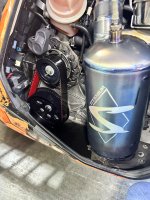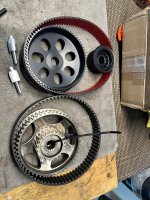F
FlynHigh
Well-known member
Kurt’s has a modification to eliminate the P22 center bearing so the belt rides lower in the primary like a P85 and hence lower “ratio” when starting out. Does require adding the adjuster set screw back to the secondary. Which I would then recommend rebalancing the secondary.Not stock belt. The TKI has a tensioner. The tensioner allows multple gearing choices but it does much more than that. As the tensioner pushes in, the belt is forced to wrap 3/4 the around the top gear. This makes for much more teeth contacting than the stock set up. When there is more contact a smaller top gear is adequate without slipping or stripping the belt. Now the top gear is smaller, a smaller lower gear is also possible without compromising ratio. this smaller bottom gear helps avoid contact with the belly pan. I have seen several broken lower gears and going larger on the lower is worse for clearance.
Keep in mind Doo and Cat traditionally run 2.5:1 or even lower gearing(higher ratio) and why do you think they chose that when Polaris went with 2.27? Polaris has been limited due to physical size and no tensioner. But you can see the trend has been toward lower gearing over the past couple years. For those gearing up I will argue all day that there is zero advantages for mountain riding. Now that Polaris uses the P22 clutch that is wider around the center bearing, these sleds start out in a higher gear than the P85. This is a huge disadvantage, especially for the turbos that lack bottom end compared to the NA's.








